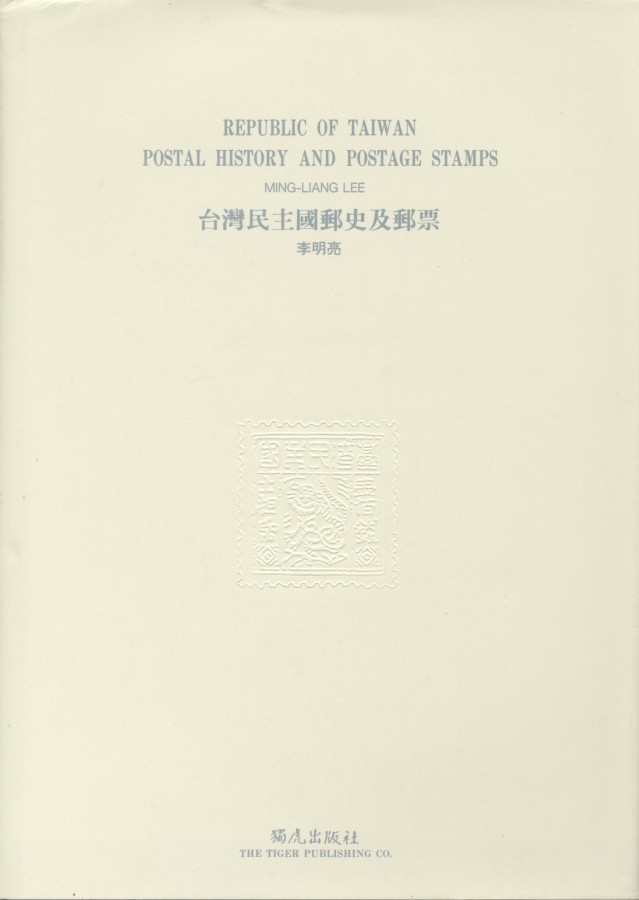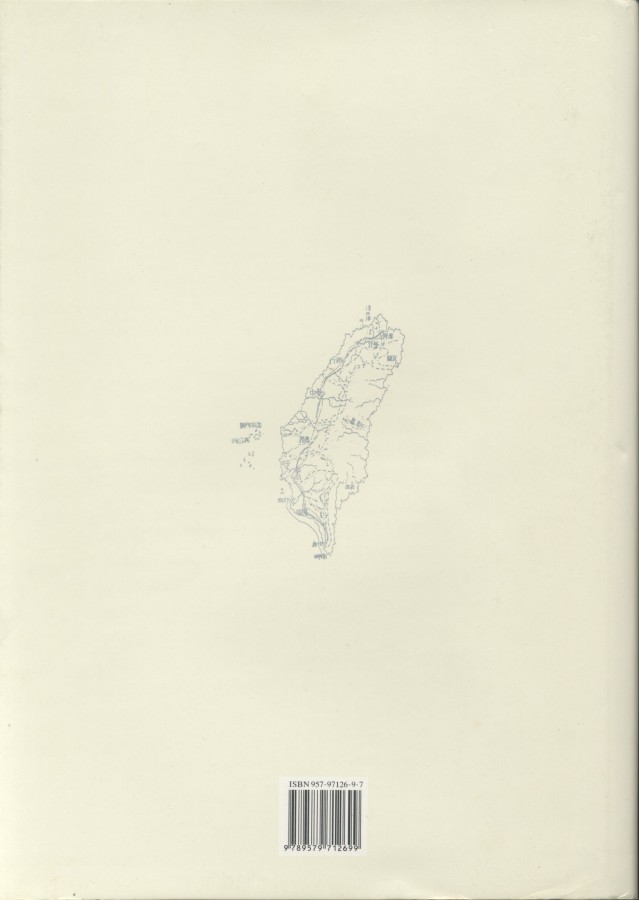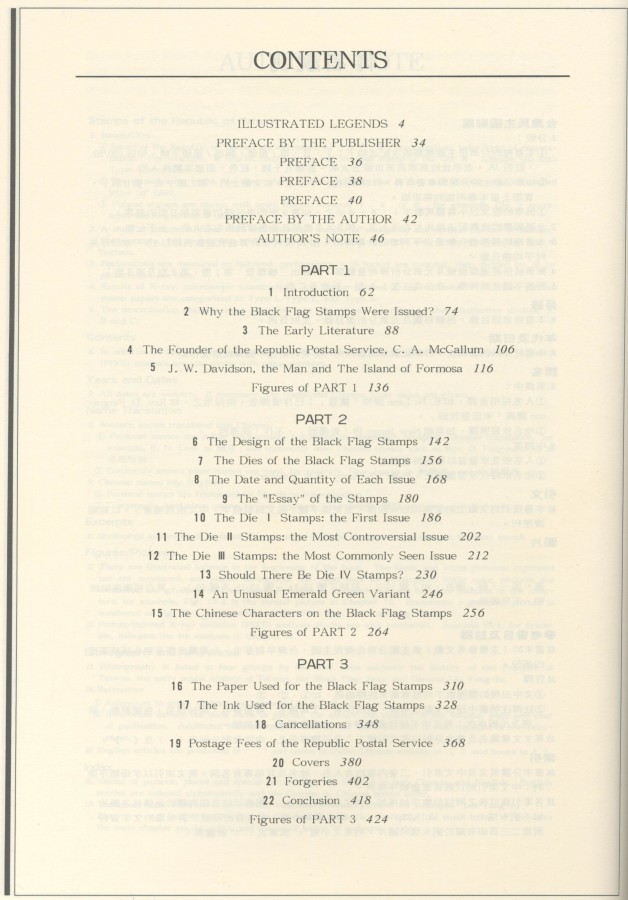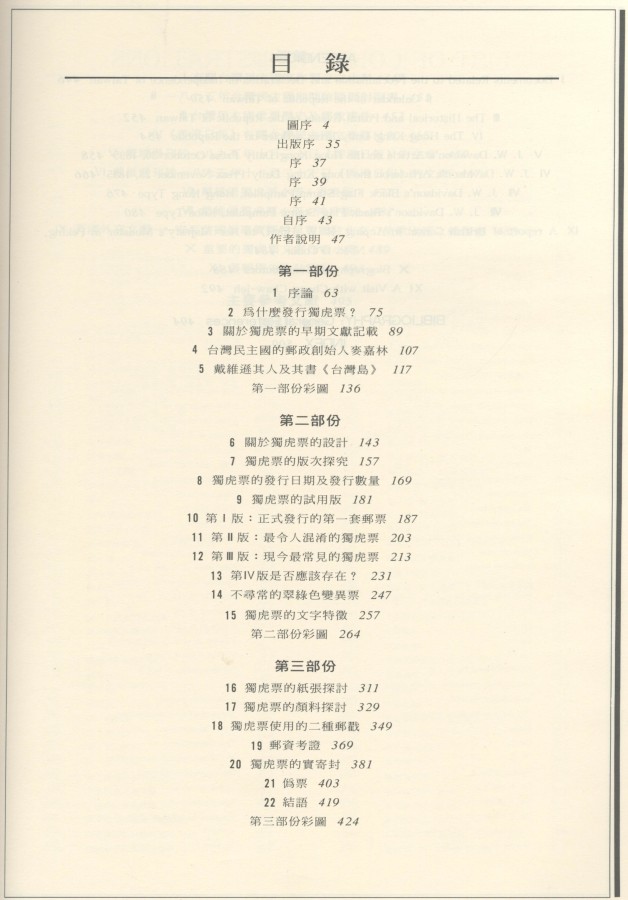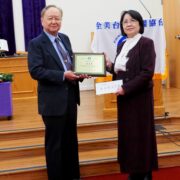台灣民主國郵史及郵票
作者 李明亮
自序
一九六六年夏天,當我就讀硏究所時,偶然在街上郵店瞥見一套郵票,上面寫著「台灣民主國」,我猶豫地把它買下來。回想中學和大學的歷史課程,我記不起來有此共和國的存在,也想不起有哪一本郵票目錄曾經刊載這套郵票。這個偶然的契機促使我展開漫長的、遍及全球的文獻蒐索,最後完成這本書《台灣民主國郵史及郵票》。這套郵票在國外通常被稱爲「一八九五年的台灣黑旗票」,在台灣則多稱之爲「獨虎票」。
自一九六六年起,我開始與世界上無數的圖書館連絡,得見許多集郵家的收藏,也與很多論述獨虎票的作者交換意見。在這個過程中,我盡可能以照相的方式攝取圖片,並有計劃地收集零零碎碎的文獻,一九九〇年初,這本書的英文初稿總算完成。
這本書可以分成三個部份:
第一部份(一至五章)回顧一般文獻,包括當年郵政事務創辦人麥嘉林在台灣服務的簡單但半推測性的描敘,以及一篇關於美國駐台領事戴維遜的詳細傳記。至於劉永福將軍的生平,則請參閱書末〈主要參考文獻〉裡所列的參考書籍。
第二部份(六至十五章)是討論郵票的設計、分版、發行日期以及發行數量。這裡面涵蓋了各版的歷史背景與特徵,同時收錄我對所謂「翠綠三十錢變異票」的看法,以及可能爲僞票的第IV版的推論。
第三部份(十六至二十二章)論及郵票紙質與顏料的化學組成、郵戳、郵資、實寄封、以及僞票。
最後是附錄。民主國的獨立文獻與重要歷史事件分別收於附錄Ⅰ和附錄Ⅲ。爲使讀者有一明確的時間關係,附錄Ⅱ將民主國的西曆、農曆日期加以對照。公元一八九五年是乙未,光緒二十一年,日本明治二十八年,也是台灣民主國(共和國)永清元年。附錄Ⅳ錄取當年刊載於《香港日報》之有關獨虎票卻常常被以訛傳訛的文章篇目,其中二篇全文轉載於附錄Ⅴ與附錄Ⅵ。戴維遜曾經出版二本著名的小郵册(香港版及神戶版),這二本小册裡的文章則轉載於附錄Ⅶ和附錄Ⅷ。關於民主國的結束過程的描述則摘錄於附錄Ⅸ。附錄Ⅹ簡單介紹了對獨虎票的硏究卓有貢獻者,可提供讀者進一步瞭解民主國郵政史,最末是附錄XI,最後一位民主國見證者-張朝摺先生-的訪談錄。此外,書末的〈主要參考文獻〉簡單介紹了本書重要的參考書目。
本書收錄了很多文獻,其中大部份均未被討論過。多年來,作者發現許多有關獨虎票的記載事實上錯誤卻廣泛地爲人援引。因此本書盡量把論點的來源——羅列,尤其是早期文獻以及原始資料。
本書的出版刻意安排在台灣民主國一百週年,即公元一九九五年。亞洲第一個共和國似乎早被淡忘。台灣的獨立自主,一直不被海峽二岸接受。諷剌的是,當年宣布獨立的唯一目的是要台灣回歸祖國。縱然一百年在人類歷史上不算長,可是我們可以很清楚地印證歷史是如何快速地爲人遺忘。我很感謝普林斯頓大學圖書館,讓我有機會看到當年協助戰後中國與日本談判中日甲午戰爭條約的美國領事約翰•福斯特的原始手寫資料。這些泛黃、易碎的破舊紙張把歷史活生生地回顯到眼前,使一個百年後生長於台灣的人有難以付諸紙筆的感觸。在獨立一百年之後出版本書對我有一個特別的意義,因爲我生長在台灣民主國崛起旋而滅亡的地方,台南府。
我必須感謝許多人的幫忙,沒有他們的協助,本書絕對無法完成。他們包括在美國賓州大學園的美國郵政協會硏究圖書館的吉妮•霍恩與蘇珊•狄克遜小姐,B•威爾屈及A•M•布里斯托先生;前台北郵政博物館館長鄭文正先生,館員高添成先生;台灣省立博物館人類學組長阮昌銳先生;普林斯頓大學圖書館多位先生;紐約集郵會的圖書館員;加州比爾曼郵政圖書館館員;倫敦大英博物館;倫敦公共資料檔案處;華盛頓司密遜尼安博物館;台南市立圖書館;台南市民俗文物館;台灣銀行經濟硏究室袁穎生副主任;普林斯頓市立圖書館;芝加哥硏究圖書館中心以及我曾經服務的醫學院——新澤西州立醫牙科大學醫學圖書館。
很多先進及朋友都給我極大的支持:李建慶先生、張厚基先生、黃明正先生、朱棟槐先生、成功大學石萬壽教授、美國農業部李賢淇教授、日本黃昭堂教授、前文化大學邱棨鐊教授、我的同事蔣莎菲醫師、朱慧敏小姐、美國威斯康辛州農業部森林產物實驗室的柯莉斯汀小姐、台北吳樂園先生、加拿大都根先生,以及我的女 兒李悅舟,他們幫我尋得不少文獻資料。我非常感謝《中國飛剪》主編奧力山大先生、維吉尼亞州的哥德先生、英國的蘭恩先生、美國印弟安那州曾澤錄醫師、前台灣郵政硏究所的曹潛先生、蔡英清先生及陳俊雄先生,他們都給我無數有益的建議與討論,指正我很多原文中譯上的錯誤。我要特別感謝鹿港張敏生醫師和基隆的蔡英清先生,他們慷慨地與我分享他們寶貴的收藏,還有美國新澤西州盧特格大學化學系的郝爾教授,他幫忙我做化學元素的分析工作。張敏生醫師、陳鄭添瑞醫師及黃富三教授三位先進不吝賜序,受之有愧,再次誌謝。我衷心感謝我以前的秘書路格斯夫人以及張慈桂講師,她們二位都十分用心地幫我處理英文文件,中譯文字則必須感謝獨虎出版社總編輯王威智先生的細心整理,以及花蓮慈濟醫學院的張翠美、蕭惠敏及王碧霞小姐的鼎力相助。在出版方面,我很幸運地認識花蓮獨虎出版社一對年輕有爲的社長夫婦,曾明誠與陳秀美,他們完成了不凡的美術編輯工作。經費方面則感謝台南醫界的朋友韓良誠、黃仁村、李浩銑、余獻章及高壽龍五位醫師,以及台南一中的一群同學,他們的資助使本書得以順利出版。
我最大的謝意應歸予台灣烏日的陳鄭添瑞醫師,他無條件無限期地將極其寶貴的,有關台灣民主國郵票的收藏借予我做硏究。本書有許多圖片亦由陳鄭添瑞醫師提供(太多了,故無法在此——致謝),若非他的仗助,本書勢必不克如期竟功,內容亦將大爲失色。最後我要感謝內人雅慧長期的鼓勵與支持,還有女兒悅舟、康舟、培舟,她們都幫我整理了英文原稿及內容。
我在此向未能致謝的襄助者深表歉意。
當然,獨虎票的硏究尙未結束,因爲諸多問題仍待解答。本書的某些結論至多是暫時性的,若有絲毫錯謬,我願負全責。如果對我有任何批評或建議,我將非常感謝。
李明亮
花蓮•台灣
一九九五年十月
PREFACE
When I was a graduate student in the summer of 1966, I happened to come across a set of stamps labeled “Republic of Taiwan,” which I purchased with hesitation. Recalling my history courses in high school and college, I could not remember the existence of this Republic, nor could I remember the listing of these stamps in any stamp catalog. That incident propelled me on a long journey and an extensive worldwide literature search, which led to this book, Republic of Taiwan, Posta/ History and Postage Stamps. The stamps are commonly known as the Black Flag issue of Taiwan, 1895.
Since 1966, I have contacted numerous libraries around the world, examined the collections of many philatelists and communicated with many who have written articles on the Black Flag issue. I photographed as many originals as I could, assembled the fragmented information and completed the first draft of this text in early 1990.
The book can be divided into three sections:
The first part (Chapters 1-5) is on a general review of the literature, including a brief, somewhat speculative account of the life of the founder of the postal service, C. A. McCallum, as well as a detailed biography of James W. Davidson, the U. S. Consul of Taiwan. For the life of General Liu Yung-fu, the reader may find it useful to consult the bibliography at the end of this book for further information.
The second portion (Chapters 6-15) is devoted to the design of the stamp and its classification, the date and the numbers issued. Also covered are the individual dies (issues) and their characteristics, including the so called “rare error of color die” or “emerald, damaged die” of 30 cash green, and Die IV , a possible forgery.
The third section (Chapters 16-22) deals with the chemical analysis of the paper and ink, cancellations, postage, covers, and, finally, forgeries.
The last section is given to appendices. Historical events and documentation are in Appendices I and IE . For the reader^ convenience, a calendar of the entire Republic in both western and Chinese lunar dates is listed in Appendix II . It is worth mentioning that the year 1895 was Kuan Shue (光緒)year 21 of China, or year Yie Wei (乙未),or Mei Jie (明治)year 28 of Japan, or Yong Chin (永清),the first year of the Republic of Taiwan. Many important articles from the Hong Kong Daily Press regarding the Black Flag issue, which were often misquoted in literature, are presented in table form in Appendix IV . Two particularly pertinent articles are reproduced in their entirety in Appendices V and VI . Davidson’s famous pamphlets in both Hong Kong and Kobe type are also included in Appendices MI and VD1 . A description of the ending of the Republic is excerpted in Appendix K . Brief biographic sketches of main literary contributors are presented in Appendix X,and finally, a record of a visit to the last man of the Republic, Mr. Chang Chaw-jeh, is in Appendix XI . In addition, the Bibliography provides a brief description of the sources of monographs cited in the text.
This book cites a great deal of literature, much of which has never been discussed before. Over the years, I found much misinformation in the philatelic records, which had been widely quoted de facto. In this book, I cite the references in as much detail as possible, paying particular attention to early literature and original material.
It is my intention to coordinate the publication of this book with the 100th anniversary of the Republic of Taiwan, 1995. This short-lived Republic, the first in Asia, has long been forgotten. The Republic of Taiwan sought self-determination, an idea tolerated by neither the Communist Government of mainland China nor the Nationalist Chinese government in Taiwan. Ironically, the sole purpose of the proclamation of the Republic was to return Taiwan to China. One hundred years is not a long time in the history of any people, yet it is astonishing to realize how fast history can be forgotten. Thanks to the Princeton University Library, I had the opportunity to read the original writings of John W. Foster, the chief consultant to the Chinese Government during the negotiations of a post-war treaty with the Japanese. The faded, fragile yellow papers vividly revealed the past, stirring a feeling beyond description for me as a Taiwanese living 100 years later. Publishing this book in the year 1995 holds a special meaning for me, for I was born and raised in the town of Tainan (Tainanfu during the Republic), where the Republic rose and fell.
Needless to say, I am tremendously grateful to countless numbers of people, without whom this work would not have been possible: Miss Gini Horn, Miss Susan Dixon, Messrs. Bill Welch and A. Mercer Bristow of The Philatelic Research Library, American Philatelic Society, College Park, Pennsylvania; Mr. John Chien, the former director of Postal Museum of Taipei; Messrs. Kao Tien-chen of the Postal Museum of Taipei; Mr. C. H. Yuen of Taiwan Museum, Taipei; Mr. Martin Heijdra of the Princeton University Library; librarians at the Collectors Clubs of New York; Bierman Philatelic Library of Beverly Hills, California; The British Library of London; The Public Record Office in London; The Smithsonian Institute in Washington, D. C.; The City Library of Tainan, Taiwan; The Princeton Public Library, Princeton; The Center for Research Libraries, Chicago, IL; and my former medical school library, University of Medicine and Dentistry of New Jersey, Robert Wood Johnson Medical School.
I owe thanks to Messrs. Lee Chien-chin, Henry K. Chang, Huang Min-jeng, and Chu Tong-hwai; History Professor Shyr Wan Show; Dr. Edward H. Lee of the United States Department of Agriculture; Professor Ng Yuzin Chiautong of Japan; former Professor of Chinese Culture Institution of Taipei Dr. Frank Chiu; my associates Dr. Sophie Jiang and Miss Zhu Huei-min; Miss Donna Chritensen of the U.S. Department of Agriculture Forest Product Laboratory, Madison, WI; Mr. Wu Lo-yuan of Taipei; Charles W. Dougan of Surrey, Canada: and my daughter Charissa Lee, for their help in locating research sources. I thank the Chief Editor of China Clipper, Mr. Donald R. Alexander; Mr. Stephen Gates of Virginia; E. N. Lane of England; Dr. Tseng Che- lu of Indiana; the former Director of Postal Institute of Taiwan, Mr. Tsao Chien; and Mr. Chen Chun-shiong and Tsai Eing-ching, for their valuable suggestions, discussions, readings of the manuscript and corrections of the Chinese translations. Special thanks to Dr. Chang Min-sheng of Lukang, Taiwan, and Mr. Tsai Eing-ching of Taipei for their generous sharing of their collections, and to Dr. Gene S. Hall of the Department of Chemistry, Rutgers University, New Brunswick, NJ, for his performance of chemical analysis. I am honored that Drs. Chang Min-sheng, Chen-Cheng Tien-zwei and Professor Huang Fu-san have written the prefaces. I am deeply grateful. My sincere appreciation and thanks to my former secretary Ms. Judy Lukacs; my colleague, Instructor Chang Tsu-Guey; and Naomi Alag, Hsiao Hui-min, Wang Pih- shya and Mr. Wang Wei-jyh, the Chief Editor of The Tiger Publishing Co., who painstakingly transcribed, typed and edited my Chinese manuscript. For publishing this book, I am extremely lucky to have excellent technical assistance from an enthusiastic young couple, Tzeng Min-chen and Chen Show-mei, co-managers of The Tiger Publishing Co. Medical collegues from Tainan, Drs. Hahn Liang-cheng, Huang Zen- chuan, Lee Hao-hsien, Yu Hsien-chang and Soulon Kao and a group of Tainan High School classmates, all kindly offered financial support, making the timely publication of the book possible.
Particular thanks to Dr. Chen-Cheng Tien-zwei of Taiwan who unconditionally, and for an unlimited time, lent me his priceless collection from which many of the reproductions were made. Many of the photographs in this book, too many to acknowledge individually, are the courtesy of Dr. Chen-Cheng. Without his trust and generosity my work would have been very much slower and incomplete. Finally my gratitude to my wife, Yahwei, who has had unlimited patience for indulging my study, and who provided support and encouragement when I needed it the most. It is Yahwei and my daughters Charissa, Tania and Mae, who assisted with the editing of the text.
My sincere apologies to those I have failed to acknowledge.
Of course, the study of the Black Flag issue of Taiwan is not closed, nor finished, for many questions remain to be answered. Some of the conclusions I have drawn are tentative at best, and for any errors, I am solely responsible. Please forward any comments or suggestions to me, which will be greatly appreciated.
Ming-liang Lee, MD, PhD Hualien, Taiwan
作者簡介
李明亮,一九三六年生於台灣台南(台南府),一九五五年畢業於台南一中,一九六二年畢業於台灣大學醫學系,曾住美國杜克大學小兒科住院醫師,一九六九年取得邁阿密大學生物化學及分子生物學博士學位。其後歷任英國劍橋大學轚學硏究所分子生物硏究室惠持尼硏究員、邁阿密大學助理教授、美國約翰•霍普金斯醫院硏究員、美國新澤西州立醫牙科大學醫學院小兒科副教授、正教授及遺傳醫學科主任:一九九二年任花蓮慈濟醫學院籌備處主任,一九九四年任創校校長。
李博士目前借妻廖雅慧定居於台灣花蓮:長女悅舟與次女康舟分別畢業於喬治城大學商學院硏究所及哥倫比亞大學伯納學院,三女培舟就讀於麻省理工學院。
Ming-Hang Lee was born in 1936 in Tainan (Tainanfu), Taiwan. He graduated from Tainan First Boys’ High School in 1955, and from College of Medicine, National Taiwan University in 1962. He had a year of Pediatric residency at Duke University before entering the Graduate School, University of Miami, where he received a Ph.D. in Biochmistry and Molecular Biology. He was a Helen Hay Whitney Research Fellow at the Laboratory of Molecular Biology, Medical Research Council, Cambridge University; an Assistant Professor at University of Miami; Chief Fellow at Johns Hopkins Hospital; and an Associate Professor, Professor and Chief of Medical Genetics at Robert Wood Johnson Medical School, University of Medicine and Dentistry of New Jersey. In 1992 He was appointed Director of the Preparatory Office of Tzu Chi College of Medicine, and in 1994, its Founding President.
Dr. Lee lives in Hualien, Taiwan, with his wife, Liau Yahwei. They have three daughters. Charissa graduated from Business School, Georgetown University; Tania graduated from Barnard College, Columbia University; and Mae is a Senior at Massachusetts Institute of Technology.
Posted in 2015/10

